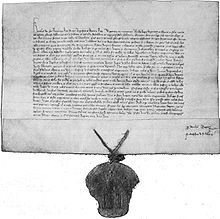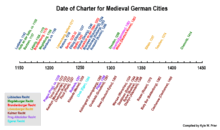- German town law
-
German town law (German: Deutsches Stadtrecht) or German municipal concerns (Deutsches Städtewesen) concerns town privileges used by many cities, towns, and villages throughout Central and Eastern Europe during the Middle Ages.
Contents
Town law in Germany
As Germans began establishing towns throughout northern Europe as early as the 10th century, they often received town privileges granting them autonomy from local secular or religious rulers. Such privileges often included the right to self-governance, economic autonomy, criminal courts, and militia. Town laws were more or less entirely copied from neighboring towns, such as the Westphalian towns of Soest, Dortmund, Minden, and Münster. As Germans began settling eastward, the colonists modelled their town laws on the pre-existing 12th century laws of Cologne, Lübeck in the north (Lübeck law), Magdeburg roughly in the center (Magdeburg rights), and either Nuremberg or Vienna in the south (South German law).
Because many larger cities such as Braunschweig and Hildesheim grew through the agglomeration of neighboring towns, some previously self-contained settlements were split between regions utilizing differing town rights variants.
The granting of German city rights modelled after an established town to a new town regarded the original model as a Rechtsvorort, or roughly a legal sponsor of the newly-chartered town. For instance, Magdeburg became the sponsor of towns using Magdeburg Rights, and its lay judges could rule in ambiguous legal cases in towns using such rights. Certain city rights became known under different names, although they originally came from the same source; the name of some city variants designates the Rechtsvorort they became famous from, not necessarily that that specific style of rights originated from the Rechtsvorort.
As territorial borders changed through the passage of time, changes to German city rights were inevitable. During the course of the 15th, 16th, and 17th centuries, the town laws of many places were modified with aspects of Roman law by legal experts. Ultimately, the older towns' laws, along with local autonomy and jurisdiction, gave way to landed territorial rulers. With the Reichsdeputationshauptschluss of 1803, almost all of the 51 reichsfrei cities of the Holy Roman Empire were mediatised by the territorial princes; the remaining imperial free cities of Frankfurt, Bremen, Hamburg, and Lübeck became sovereign states. The only remnants of medieval town rights (statutes) included in the Bürgerliches Gesetzbuch of 1 January 1900 were single articles concerning family and inheritance laws. The cities of Hamburg, Bremen, and Berlin are currently administered under Landesrechte, or laws of the federal states of Germany.
Town layout
Many towns granted German city rights had already existed for some time, but the granting of town law codified the legal status of the settlement. Many European localities date their foundation to their reception of a town charter, even though they had existed as a settlement beforehand.
Cities with German city rights often had similar layouts. Somewhat isolated was part of the city containing the residence and castle of the regional ruler, along with a cathedral. The city proper was centered around a market square which featured a church for wealthy merchants and artisans. Streets led out from the market in a planned grid system or concentric circles in which less wealthy citizens lived; riverfront sections of a city were designed with semicircles. The perimeter of the city was guarded by defensive walls, gates, and moats. If the city had already existed as a settlement, pre-existing defenses were sometimes incorporated into the fortifications. Cities whose layouts depict this type of urban planning include Wrocław, Kraków, Vienna, Brno, and Prague.
Towns with German law developed in differing density depending on their locations. In much of northern Europe, the regular positioning of many smaller cities was planned. In the middle region, towns were compactly located near another as a continuation of the dense cities of middle Germany. In the south the town density was meager, although there existed many markets which lacked town charters.
Eastward colonization
German town law was frequently applied during the Ostsiedlung of Central and Eastern Europe by German colonists beginning in the early 13th century. Because many areas were underpopulated or underdeveloped, local rulers offered urban privileges to peasants from western Germany to induce them to immigrate eastward. Some towns which received a German law charter were based on pre-existing settlements, while others were constructed anew by colonists. Many towns were formed in conjunction with the settlement of nearby rural communities, but the towns' urban rights were jealously guarded. Initially German town law was applied only to ethnic Germans, but gradually in most localities all town-dwellers were regarded as citizens, regardless of ethnic origin.
Lübeck law spread rapidly among the maritime settlements along the southern shore of the Baltic Sea and was used in northern Mecklenburg, Western Pomerania, and parts of Pomerelia and Warmia. It formed the basis of Riga law in Riga, used in the lands of the Livonian Order in Livonia, Estonia, and Courland.
Magdeburg law was popular around the March of Meißen and Upper Saxony and was the source of several variants, including Neumarkt-Magdeburg law (Środa Śląska), used extensively in Upper Silesia, and Kulm law, used in the territory of the Teutonic Knights in Prussia and along the lower Vistula in Eastern Pomerania. Other variants included Brandenburg, Litoměřice, and Olomouc law.
Litoměřice law and codes based on that of Nuremberg, such as Old Prague and Cheb law, were introduced into Bohemia during the reign of King Wenceslaus I, while German colonists introduced Brünn (Brno) and Olmütz (Olomouc) law in Moravia. South German law, broadly referring to the codes of Nuremberg and Vienna, was used in Bavaria, Austria, and Slovenia, and was introduced into the Kingdom of Hungary during the rule of King Béla IV. Jihlava law was a variant used frequently by mining communities in Bohemia, Moravia, the mountains of Slovakia, and Transylvania. Other town laws were only suitable for or were modified to fit local conditions, such as Głubczyce, Görlitz, Goslar, Lüneburg, Lwówek Śląski, Nysa, Spiš, and Székesfehérvár laws.
Resulting from the reign of King Casimir III of Poland, numerous towns were chartered with Neumarkter law throughout the Kingdom of Poland in the 14th century, especially in Masovia, Galicia, and Volhynia. Many Transylvanian Saxon settlements in Transylvania, especially in the regions of Altland, Burzenland, and Nösnerland, received South German law in the 14th century.
In the 15th century, many towns in the Grand Duchy of Lithuania were chartered with the Neumarkter law used in much of Poland, although this was done through the duplication of Polish administrative methods instead of German colonization. In the 16th century Muscovy granted or reaffirmed Magdeburg rights to various towns along the Dnieper acquired from the Polish-Lithuanian Commonwealth. After the Partitions of Poland, Magdeburg law continued to be used in western Imperial Russia until the 1830s.
It is important to keep in mind that although many towns outside of the Holy Roman Empire had significant German populations, in some cases a town being a "German city" referred to its legal system based on German law, not necessarily meaning it had a German population. Especially in Eastern Europe, most towns had minimal German populations, if any at all.
See also
- List of towns with German town law
- Kulm law
- Lübeck law
- Magdeburg rights
- Ostsiedlung
- Town privileges
- Burgrecht
References
- Christiansen, Eric. The Northern Crusades. Penguin Books. London, 1997. ISBN 0-14-026653-4
- Krallert, Wilfried. Atlas zur Geschichte der deutschen Ostsiedlung. Velhagen & Klasing. Bielefeld. 1958.
- Magocsi, Paul Robert. Historical Atlas of Central Europe: Revised and Expanded Edition. University of Washington Press. Seattle. 2002. ISBN 0-295-98193-8
- Westermanns Atlas zur Weltgeschichte. Georg Westermann Verlag Braunschweig. Berlin. 1963.
- This article incorporates information from the revision as of retrieved 6 May 2006 of the equivalent article on the German Wikipedia.
External links
Categories:- German law
- Urban planning in Germany
- German diaspora
- German communities
Wikimedia Foundation. 2010.


